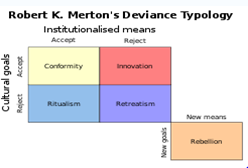Definitions:
Being so open-ended a concept, it is natural that there should be some disagreement, even among learned scholars, about what exactly deviance is.
Deviance as a violation of social norms
Norms are specific behavioural standards, ways in which people are supposed to act, paradigms for predictable behaviour in society. They are not necessarily moral, or even grounded in morality; in fact, they are just as often pragmatic and, paradoxically, irrational. (A great many of what we call manners, having no logical grounds, would make for good examples here.) Norms are rules of conduct, not neutral or universal, but ever changing; shifting as society shifts; mutable, emergent, loose, reflective of inherent biases and interests, and highly selfish and one-sided. They vary from class to class, race to race and in the generational “gap.” They are, in other words, contextual.
It is often hard, therefore, to come to a broad consensus about which behaviours are acceptable and which are not. It is all very subjective, and definitions of deviance, accordingly, are subjective, too.
It is important to consider how norms come into being. Usually they are instituted to regulate behaviour, especially in favour of those doing the regulation; certainly, it is true that norms are used and abused for various ends. The norms held by the most powerful groups in society tend to be accepted as reference points by others.
Viewing deviance as a violation of social norms, sociologists have characterised it as “any thought, feeling or action that members of a social group judge to be a violation of their values or rules”violation of the norms of a society or group”;conduct that violates definitions of appropriate and inappropriate conduct shared by the members of a social system”; “the departure of certain types of behaviour from the norms of a particular society at a particular time”; and “violation of certain types of group norms behaviour is in a disapproved direction and of sufficient degree to exceed the tolerance limit of the community.
There is a difference, of course, under this definition between norms and formal law, and accordingly their respective violations. The law, concerned greatly with morality and social order, strives to be objective; norms, although they have some of this in common, are by their very nature subjective.
Deviance need not always be negative; indeed, it is often a vehicle for changing society for the better. As one widely-circulated motivational tome has it,A quick glance at history reveals that the individuals who impacted their generations and affected the world most dramatically were individuals who, because of a circumstance, pressure, or decision, challenged the tide of convention, stretched the boundaries of tradition, and violated the expectations of the norm. Few great things have ever been done within the confines of the accepted norm. In essence, history is always made by individuals who dare to challenge and exceed the accepted norm. Why follow a path when you can make a trail? Have we settled for the norm? I am convinced that our Creator never intended for us to be normal that is, to get lost in the crowd of “the norm”. Traditions are powerful enemies of potential because they are full of security. We don’t have to think when we do something the way we’ve always done it. Remember, no matter how good the present system is, there’s always a better way. Refrain from accepting or believing, “We’ve never done it that way before.”
Without deviance, in other words, society would be stagnant: to restrict oneself to the bornes of tradition is a good idea for anyone (or any society) looking to move forward. Although generally unpopular and occurring in small pockets, deviance can have a telling impact; indeed, it has the capacity eventually not to be deviant at all, but rather to become socially acceptable, or even ultimately the norm. Such were the goals of, for instance, the racial-equality movements.
Deviance as reactive construction
This definition of deviance is concerned with the process whereby the conduct of one person comes to be viewed as deviant by others, through labelling and social typing. Most commonly it is seen as a rejection of biological, psychological and other innate traits. Although in some perspectives humans are thus seen as little more than automatons, this is not a pervasive view among those who hold to this definition; the counter view believes us to be active agents who can think and give meaning to any situation.
Theories
The sociology of deviance involves a number of theorems that seek accurately to describe trends and patterns discernible in the study of social deviance, the better to understand social behaviour. There are three broad sociological classes describing deviant behaviour, namely structural functionalism, symbolic interactionism and conflict theory.
Structural-Functionalism
Social integration is the attachment to groups and institutions, while social regulation is the adherence to the norms and values of the society. Those who are very integrated fall under the category of “altruism” and those who are very unintegrated fall under “egoism.” Similarly, those who are very regulated fall under “fatalism” and those who are very unregulated fall under “anomie”. Durkheim’s strain theory attributes social deviance to extremes of the dimensions of the social bond. Altruistic suicide (death for the good of the group), egoistic suicide (death for the removal of the self due to or justified by the lack of ties to others), and anomic suicide (death due to the confounding of self-interest and societal norms) are the three forms of suicide that can happen due to extremes. Likewise, individuals may commit crimes for the good of an individual’s group, for the self due to or justified by lack of ties, or because the societal norms that place the individual in check no longer have power due to society’s corruption.

Merton’s strain theory
Robert K. Merton discussed deviance in terms of goals and means as part of his strain/anomie theory. Where Durkheim states that anomie is the confounding of social norms, Merton goes further and states that anomie is the state in which social goals and the legitimate means to achieve them do not correspond. He postulated that an individual’s response to societal expectations and the means by which the individual pursued those goals were useful in understanding deviance. Specifically, he viewed collective action as motivated by strain, stress, or frustration in a body of individuals that arises from a disconnection between the society’s goals and the popularly used means to achieve those goals. Often, non-routine collective behavior (rioting, rebellion, etc.) is said to map onto economic explanations and causes by way of strain. These two dimensions determine the adaptation to society according to the cultural goals, which are the society’s perceptions about the ideal life, and to the institutionalized means, which are the legitimate means through which an individual may aspire to the cultural goals.
Merton expanded on the idea that anomie is the alienation of the self from society due to conflicting norms and interests by describing five different types of actions that occur when personal goals and legitimate means come into conflict with each other.
- When an individual accepts the goals and means together, he is working under conformity. (Example: White collar employee who holds a job to support a family.)
- When an individual accepts the goals but uses illegitimate means in order to achieve them, he commits crimes in order to emulate the values of those who conform; in other words, they must use innovation in order to achieve cultural goals. (Example: Drug dealer who sells drugs to support a family.)
- An individual may lose faith in cultural goals but still feel obligated to work under the routines of legitimate daily life. This person is practicing ritualism. (Example: A white collar employee who holds a job, but has become completely discontent with the American Dream.)
A young waif steals a pair of boots.
- Individuals may also reject both goals and means and fall under retreatism, when they ignore the goals and the means of the society. (Example: Drug addicts who have stopped caring about the social goals and choose a drug induced reality in favour of the socially accepted lifestyle.)
- Finally, there is a fifth type of adaptation which is that of rebellion, where the individual rejects the cultural goals and the institutionalized means, but seeks to redefine new values for society. (Example: Radicals who want to repair or even destroy the capitalist system in order to build a new social structure.)
Symbolic interactionism
Deviance, according to this view, comes from the individual, who learns his deviant behaviour. The deviant may grow up alongside other deviants or may learn to give excuses for deviance.Through their interactions, individuals create the symbolic structures that make life meaningful. Reality does not impose the names and definitions of things, but rather people must define things and make them meaningful in order to make them socially real. The focus is upon the consciousness and the mind of the individual as opposed to the institutions from where the norms come from.Symbolic interactionism allows researchers to understand how individuals negotiate, manipulate, and change the structure and reality to a certain extent. Individuals are already born into a society which has symbolic structures. “Emotion processing is pivotal during development and deficient processing of certain emotions disrupts normal socialization increasing risk for violent behavior later in life. Psychopathy has been linked to both of these phenomena in men; however, the study of such relations has been relatively neglected in women. In the present study, 88 collegiate women completed measures of psychopathy, aggression, and a lexical-decision-task (LDT) assessing the processing of affective words”. “Research has demonstrated that (in)effective parenting influences whether a child/adolescent engages in deviant behaviors; however, research is mixed regarding whether that influence is direct.”
Sutherland’s differential association
In his differential association theory, Edwin Sutherland posited that criminals learn criminal and deviant behaviors and that deviance is not inherently a part of a particular individual’s nature. Also, he argues that criminal behavior is learned in the same way that all other behaviors are learned, meaning that the acquisition of criminal knowledge is not unique compared to the learning of other behaviors.
Sutherland outlined some very basic points in his theory, such as the idea that the learning comes from the interactions between individuals and groups, using communication of symbols and ideas. When the symbols and ideas about deviation are much more favorable than unfavorable, the individual tends to take a favorable view upon deviance and will resort to more of these behaviors.
Criminal behavior (motivations and technical knowledge), as with any other sort of behavior, is learned. Some basic assumptions include:
- Learning in interaction using communication within intimate personal groups.
- Techniques, motives, drives, rationalizations, and attitudes are all learned.
- Excess of definitions favorable to deviation.
- Legitimate and illegitimate behavior both express the same general needs and values.
Neutralization theory
Gresham Sykes and David Matza’s neutralization theory explains how deviants justify their deviant behaviours by providing alternative definitions of their actions and by providing explanations, to themselves and others, for the lack of guilt for actions in particular situations.
There are five major types of neutralization:
- Denial Of Responsibility: the deviant believes s/he was helplessly propelled into the deviance, and that under the same circumstances, any other person would resort to similar actions
- Denial Of Injury: the deviant believes that the action caused no harm to other individuals or to the society, and thus the deviance is not morally wrong
- Denial Of The Victim: the deviant believes that individuals on the receiving end of the deviance were deserving of the results due to the victim’s lack of virtue or morals
- Condemnation Of The Condemners: the deviant believes enforcement figures or victims have the tendency to be equally deviant or otherwise corrupt, and as a result, are hypocrites to stand against
- Appeal To Higher Loyalties: the deviant believes that there are loyalties and values that go beyond the confines of the law; morality, friendships, or traditions may be more important to the deviant than legal boundaries
Labelling theory
Frank Tannenbaum and Howard S. Becker created and developed labelling theory, which is a core facet of symbolic interactionism, and often referred to as Tannenbaum’s “dramatisation of evil.” Becker believed that “social groups create deviance by making the rules whose infraction constitutes deviance.”
Labelling is a process of social reaction by the “social audience,” the people in society exposed to, judging and accordingly defining (labelling) someone’s behaviour as deviant or otherwise. It has been characterised as the “invention, selection, manipulation of beliefs which define conduct in a negative way and the selection of people into these categories
Labelling theory, consequently, suggests that deviance is caused by the deviant’s being labelled as morally inferior, the deviant’s internalising the label and finally the deviant’s acting according to that label. As time goes by, the “deviant” takes on traits that constitute deviance by committing such deviations as conform to the label. Individual and societal preoccupation with the label, in other words, leads the deviant individual to follow a self-fulfilling prophecy of abidance to the ascribed label.
This theory, while very much symbolically-interactionist, also has elements of conflict theory, as the dominant group has the power to decide what is deviant and acceptable, and enjoys the power behind the labelling process. An example of this is a prison system that labels people convicted of theft, and because of this they start to view themselves as by definition thieves, incapable of changing. “From this point of view,” as Howard S. Becker has written,
deviance is not a quality of the act the person commits, but rather a consequence of the application by others of rules and sanctions to an “offender.” The deviant is one to whom the label has successfully been applied; deviant behavior is behavior that people so label.
In other words, “Behaviour only becomes deviant or criminal if defined and interfered as such by specific people in a specific situation. It is important to note the salient fact that society is not always correct in its labelling, often falsely identifying and misrepresenting people as deviants, or attributing to them characteristics which they do not have. In legal terms, people are often wrongly accused, yet many of them must live with the ensuant stigma (or conviction) for the rest of their lives.
On a similar note, society often employs double standards, with some sectors of society enjoying favouritism. Certain behaviours in one group are seen to be perfectly acceptable, or can be easily overlooked, but in another are seen, by the same audiences, as abominable.
Primary and secondary deviation
Edwin Lemert developed the idea of primary and secondary deviation as a way to explain the process of labeling. Primary deviance is any general deviance before the deviant is labeled as such. Secondary deviance is any action that takes place after primary deviance as a reaction to the institutions.
When an actor commits a crime (primary deviance), however mild, the institution will bring social penalties down on the actor. However, punishment does not necessarily stop crime, so the actor might commit the same primary deviance again, bringing even harsher reactions from the institutions. At this point, the actor will start to resent the institution, while the institution brings harsher and harsher repression. Eventually, the whole community will stigmatize the actor as a deviant and the actor will not be able to tolerate this, but will ultimately accept his or her role as a criminal, and will commit criminal acts that fit the role of a criminal.
Primary And Secondary Deviation is what causes people to become harder criminals. Primary deviance is the time when the person is labeled deviant through confession or reporting. Secondary deviance is deviance before and after the primary deviance. Retrospective labeling happens when the deviant recognizes his acts as deviant prior to the primary deviance, while prospective labeling is when the deviant recognizes future acts as deviant. The steps to becoming a criminal are:
- Primary deviation.
- Social penalties.
- Secondary deviation.
- Stronger penalties.
- Further deviation with resentment and hostility towards punishers.
- Community stigmatizes the deviant as a criminal. Tolerance threshold passed.
- Strengthening of deviant conduct because of stigmatizing penalties.
- Acceptance as role of deviant or criminal actor.NO
Control Theory
A theory that stresses how weak bonds between the individual and society free people to deviate. By contrast, strong bonds make deviance costly. This theory asks why do people refrain from criminal behavior, instead of why people commit criminal behavior, according to Hirschi. The control theory developed when norms emerge to deter deviant behavior. Without this “control” deviant behavior would happen more often. This leads to conformity and groups. People will conform to a group when they believe they have more to gain from conformity than by deviance. If a strong bond is achieved there will be less chance of deviance than if a weak bond has occurred. Hirschi argued a person follows the norms because they have a bond to society. The bond consists of four positively correlated factors: commitment, attachment, belief, and involvement. When any of these bonds are weakened or broken one is more likely to act in defiance.
More contemporary control theorists such as Robert Crutchfield take the theory into a new light, suggesting labor market experiences not only affect the attitudes and the “stakes” of individual workers, but can also affect the development of their children’s views toward conformity and cause involvement in delinquency. This is still an ongoing study as he has found a significant relationship between parental labor market involvement and children’s delinquency, but has not empirically demonstrated the mediating role of parents’ or children’s attitude. The research will try to show a correlation between labor market stratification and individual behavior (juvenile behavior).
Conflict theory
In sociology, conflict theory states that society or an organization functions so that each individual participant and its groups struggle to maximize their benefits, which inevitably contributes to social change such as political changes and revolutions. Deviant behavior is actions that do not go along with the socially institutions as what cause deviance. The institution’s ability to change norms, wealth or status come into conflict with the individual.The legal rights of poor folks might be ignored, middle class are also accept; they side with the elites rather the poor, thinking they might rise to the top by supporting the status quo.Conflict theory is based upon the view that the fundamental causes of crime are the social and economic forces operating within society.However, it explains white-collar crime less well.
This theory also states that the powerful define crime. This raises the question: for whom is this theory functional? In this theory, laws are instruments of oppression: tough on the powerless and less tough on the powerful.
Marxism
Marx himself did not write about deviant behavior but he wrote about alienation amongst the proletariat – as well as between the proletariat and the finished product – which causes conflict, and thus deviant behavior.
Many Marxist writers have used the theory of the capitalist state in their arguments. For example, Steven Spitzer utilized the theory of Bourgeoisie control over social junk and social dynamite; George Rusche was known to present analysis of different punishments correlated to the social capacity and infrastructure for labor. He theorized that throughout history, when more labor is needed, the severity of punishments decreases and the tolerance for deviant behavior increases. Jock Young, another marxist writer, presented the idea that the modern world did not approve of diversity, but was not afraid of social conflict. The late modern world, however, is very tolerant of diversitybut is extremely afraid of social conflicts, which is an explanation given for the political correctness movement. The late modern society easily accepts difference, but it labels those that it does not want as deviant and relentlessly punishes and persecutes.
Michel Foucault
Michel Foucault believed that torture had been phased out from modern society due to the dispersion of power; there was no need anymore for the wrath of the state on a deviant individual. Rather, the modern state receives praise for its fairness and dispersion of power which, instead of controlling each individual, controls the mass.
He also theorized that institutions control people through the use of discipline.[13]“Race and ethnicity could be relevant to an understanding of prison rule breaking if inmates bring their ecologically structured beliefs regarding legal authority, crime and deviance into the institutional environment.” For example, the modern prison (more specifically the panopticon) is a template for these institutions because it controls its inmates by the perfect use of discipline.
Foucault theorizes that, in a sense, the postmodern society is characterized by the lack of free will on the part of individuals. Institutions of knowledge, norms, and values, are simply in place to categorize and control humans.
Other theories
The Classical school of criminology comes from the works of Cesare Beccaria and Jeremy Bentham. Beccaria assumed a utilitarian view of society along with a social contract theory of the state. He argued that the role of the state was to maximize the greatest possible utility to the maximum number of people and to minimize those actions that harm the society. He argued that deviants commit deviant acts (which are harmful to the society) because of the utility it gives to the private individual. If the state were to match the pain of punishments with the utility of various deviant behaviors, the deviant would no longer have any incentive to commit deviant acts. (Note that Beccaria argued for just punishment as raising the severity of punishments without regard to logical measurement of utility would cause increasing degrees of social harm once it reached a certain point.) Praveen Attri claims genetic reasons to be largely responsible for social deviance. The Italian school of criminology contends that biological factors may contribute to crime and deviance. Cesare Lombroso was among the first to research and develop the Theory of Biological Deviance which states that some people are genetically predisposed to criminal behavior. He believed that criminals were a product of earlier genetic forms. The main influence of his research was Charles Darwin and his Theory of Evolution. Lombroso theorized that people were born criminals or in other words, less evolved humans who were biologically more related to our more primitive and animalistic urges. He stated that little could be done to cure born criminals because their charcateristics were biologically inherited. Over time, most of his research was disproved.
Functions of deviance:
- Deviant acts can be assertions of individuality and identity, and thus as rebellions against group norms
Deviance affirms cultural values and norms, it also clarifies moral boundaries, promotes social unity by creating an us/them dichotomy,encourages social change,and provides jobs to control deviance. “Certain factors of personality are theoretically and empirically related to workplace deviance,such as work environment, and individual differences. Situated in the masculinity and deviance literature, this article examines a “deviant” masculinity, that of the male sex worker, and presents the ways men who engage in sex work cope with the job.”
Cross-Cultural Communication as Deviance
Cross-cultural communication is a field of study that looks at how people from different cultural backgrounds endeavor to communicate. All cultures make use of nonverbal communication but its meaning varies across cultures. In one particular country, a non-verbal sign may stand for one thing, and mean something else in another culture or country. The relation of cross-cultural communication with deviance is that a sign may be offensive to one in one culture and mean something completely appropriate in another. This is an important field of study because as educators, business employees, or any other form of career that consists of communicating with ones from other cultures you; need to understand non-verbal signs and their meanings, so you avoid offensive conversation, or misleading conversation. Below is a list of non-verbal gestures that are appropriate in one country, and that would be considered deviant in another.
| Asian | United States | Canada | United States | United States |
| Avoiding eye contact is considered polite | The O.K. signal expresses approval | Thumbs up-used for hitch hiking, or approving of something | Someone may whistle when happy. | |
| United States | Japan | United States | Nigeria | Europe |
| When saying hello or talking to someone it is impolite to not look directly at the person. | The O.K. signal means that you are asking for money. | Using your middle finger is very offensive. Used in place of inappropriate language. | This is a rude gesture in Nigeria. | Whistling may be a sign of disapproval at public events. |
These are just a few non-verbal cross-cultural communication signs of which one should be aware. Cross-Cultural communication can make or break a business deal, or even prevent an educator from offending a student. Different cultures have different methods of communication, so it is important to understand the cultures of others.
shaving of heads after death of a family member is a more in african cultures mare it does not signify anything in other cultures
Types of deviance:
Taboo is a strong social form of behavior considered deviant by a majority. To speak of it publicly is condemned, and therefore, almost entirely avoided. The term “taboo” comes from the Tongan word “tapu” meaning “under prohibition”, “not allowed”, or “forbidden”. Some forms of taboo are prohibited under law and transgressions may lead to severe penalties. Other forms of taboo result in shame, disrespect and humiliation. Taboo is not universal but does occur in the majority of societies. Some of the examples of include murder, rape, incest, or child molestation.
Deviance in literature:
Many works of literature offer allegories illustrating the conflict between character and society, in which the character does not conform to the society’s norms and is subsequently alienated, ostracized, socially sanctioned, discriminated against or persecuted.
References:
- MB Clinard and RF Meier, Sociology of deviant behavior. 1968.
- Simon Dinitz, Russell Rowe Dynes and Alfred Carpenter Clarke, Deviance: studies in definition, management, and treatment. 1975.
- JD Douglas and FC Waksler FC, The sociology of deviance: an introduction. Boston: Little, Brown, 1982.
- Gary F. Jensen, The path of the devil: early modern witch hunts. Rowman & Littlefield, 2007.
- Donal E. J. MacNamara and Andrew Karmen, DEVIANTS: Victims or Victimizers? Beverly Hills, California: Sage, 1983.
- Doug Thomson, Crime and deviance. 2004.
















